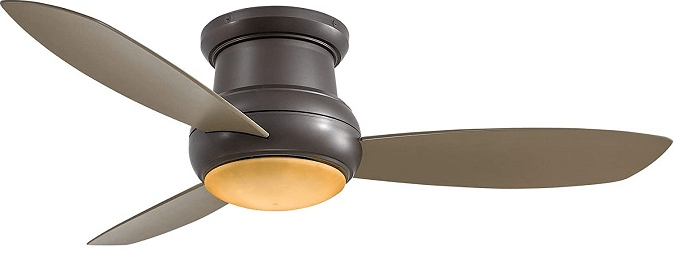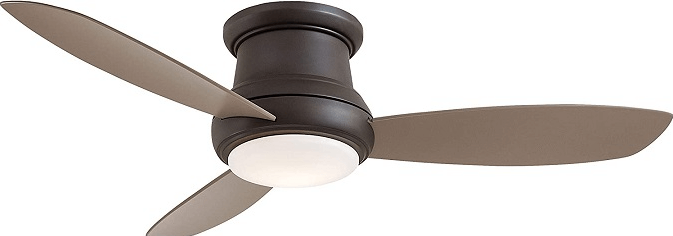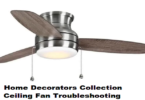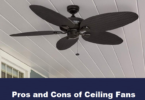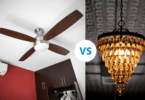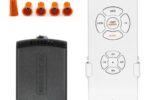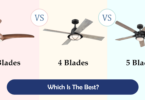Want to get clarity about outdoor vs. indoor ceiling fans? In this article, you are going to learn everything.
One of the confusions that one comes across when buying a ceiling fan is the understanding of the difference between outdoor and indoor fans. though they seem to be the same, an outdoor fan is, in many ways, the opposite of an indoor fan. The difference between the two can affect the lifespan of the fan, its style, efficiency and pricing.
In this article, we are going to discuss the differences between the outdoor and indoor ceiling fans and after reading this article, you will be able to make your decision about which type of fan you want to purchase. A few questions are also answered related to this topic.
So, let’s dive in.
Contents
Outdoor vs. Indoor Ceiling Fans – What’s the Difference
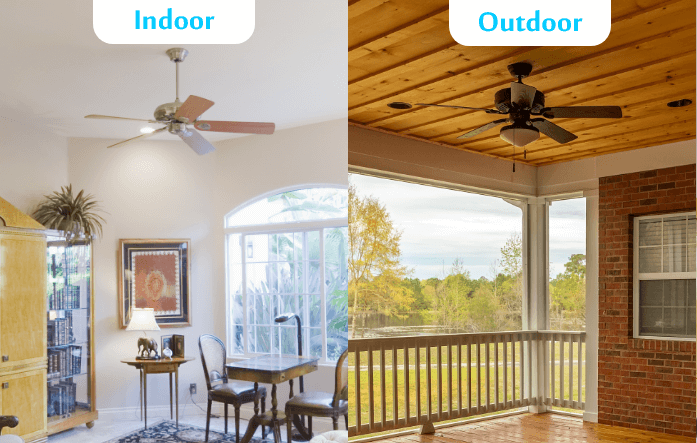
Whenever someone comes across the subject of outdoor vs. indoor ceiling fans, some people instinctively ask, “Can’t a regular fan be used outdoors?” The answer to this question is NO. in many ways, outdoor fans are different from ceiling fans that are rated as indoor. In this article, we have highlighted those differences below. Have a look at them.
Weather Rating
It is the most important factor that makes an outdoor fan unique from an indoor fan. there are three main types where users prefer to install ceiling fans including indoor spaces which are free from weather elements, uncovered outdoor spaces and covered outdoor places. Therefore, ceiling fan engineers manufacture them keeping in view these different areas in mind, they are known as Dry-rated fans, Damp rated fans and Wet rated fans. dry rated fans are installed in bedrooms for instance, where your fan will get no exposure to direct water or moisture. Damp-rated fans are used in bathrooms, covered porches, for instance, a place where they can be exposed to moisture not direct water. Wet-rated ones can be used in spaces where the fan will face direct water, areas like verandas, gazebos, pergolas and exposed decks.
Due to this reason, we can keep dry-rated fans in the indoor fan category, and put wet-rated fans and damp-rated ones in the outdoor category.
The purpose of different types of fans is to serve different types of spaces, the reason behind it is that the impact of the environment on the ceiling fan is not similar to every type of fan. You do not have to deal with the problem of moisture build-up in covered indoor areas like bedrooms. So, you can use any type of fan in this type of area safely.
When it comes to dealing with rain and moisture, the fan will be manufactured specifically to deal with these weather conditions. otherwise, the fan will be damaged due to the exposure to these weather conditions if it is not made for it. It indicates that if you will use an indoor fan in outdoor space will result in damage to the fan, including blades bent and twisted, corrosion damage, motor burnt and painting peeled off and so on.
Motor Strength
The motor strength of outdoor fans is also different from the indoor parts of the fan. as we have already discussed that outdoor units need to generate bigger airflow. Therefore, they require bigger motor as well as bigger blades.
Blade Size
The blade span and the overall size of the fans are unique to outdoor fans from indoor fans. an outdoor space is devoid of walls, when the fan pushes down the air, it will go to the ground and move away. On the other hand, in a bedroom, the air would go back to the base of the fan and again, it will be pushed down. As a result, in outdoor space, the fan has to generate a larger airflow like a hurricane. In general, outdoor units are bigger in size as compared to indoor fans.
Indoor areas can install 30-inch fans but it is a hard nut to crack to locate a small 30-inch outdoor fan, if you are looking for it, you do not have a pragmatic approach.
Style
The style of these two types of fans also differ. The difference is not very much, when it comes to outdoor models, they do not have many style options as indoor ones. The reason behind it is that the outdoor fans are constructed in such a way as to focus on the elements and protection. As a result, they have fewer options in terms of styling.
When you go through the styles, you will find that indoor fans are available in different finishes. Alternatively, outdoor fans are not available in different finishes or styles.
Price
You might be wondering if we can use outdoor fans in any space, and indoor fans cannot be installed everywhere, why not choose some outdoor fans and use them in our desired space?
The simple answer to this question is “price”.
There is no doubt that outdoor fans can be used anywhere, but the bad part is, they cost you more. The price tag is higher due to the material that gives preference to its protection from the elements. At times, the price is significantly extra. So, it is wise not to pay extra bucks if you do not have to. You will not consider a unit that costs over $350 to use in bedroom when you can get it under the price of $200. For instance.
Examples
Salt-air Resistant Ceiling Fans
From the beginning of the post, we have touched Dry-rated fans, Damp-rated fans and Wet-rated fans. Until now, we have not discussed Salt-air resistant fan. We are familiar with the fact that salt water is different from rainwater or any other type of normal water for this purpose. So, ceiling fans that have to face the environment in which they will expose to salty air need to be manufactured to withstand it. this is the reason that ceiling fan engineers launch another type of fan that is salt-air resistant ceiling fan that is designed to handle oceanside. These fans are different from wet-rated and damp-rated fans, we can call it a more sophisticated version of those units. You have to get one if you are looking for a ceiling fan that works in salty-air areas.
Hunter’s WeatherMax fans tick all the boxes for this type of fan.
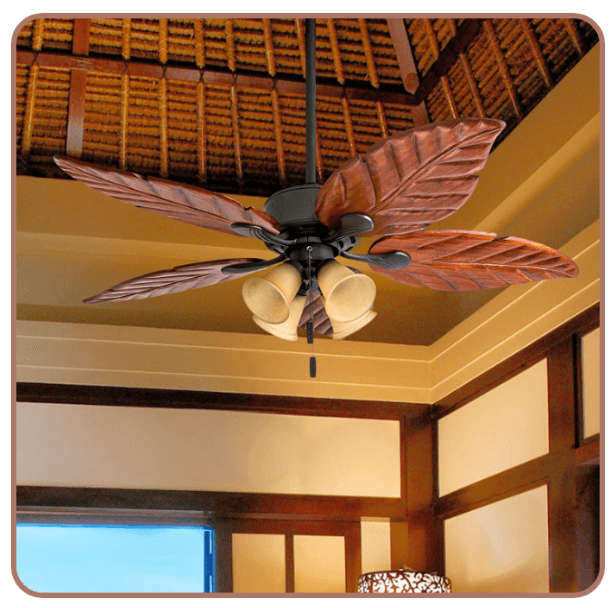
Which Type of Ceiling Fan You Should Get?
If you want to use a ceiling fan only in covered and dry indoor areas including living rooms and bedrooms, it is wise to go for a dry-rated ceiling fan and save some bucks that will be wasted on an outdoor fan.
But if you are looking for a fan that will be facing moisture, opt for a damp-rated fan. These areas can be your laundry rooms, bathrooms, patios and covered porches.
If you want to install a ceiling fan in several spaces such as uncovered outdoor areas or only in outdoor ones, select a wet-rated fan for this purpose.
If you are nearby lakeside or an ocean, it will be wise to go for a fan that is salt-air resistant as well as wet-rated too.
Can You Use Outdoor Fan Indoors?
Yes. They can be installed and used indoors. The reason is, they are made to fight any type to weather element, they can be used in living room, bedroom, bathroom and you can do it without any issue.
Can You Use Indoor Fan Outdoors?
No. it is not possible to use your indoor fan outdoors. If you try to do it, consequently, your indoor ceiling fan will get damaged, sooner than you think. The reason behind it is that indoor fans cannot bear outdoor weather and its elements including rain, moisture, snow, or high winds.
It will be ideal to use outdoor-rated fans or wet-rated fans outdoors.
Frequently Asked Questions
After that, here are some FAQs with the answers we have decided to give in the end.
Who makes the best outdoor ceiling fan?
All ceiling fan brands make outdoor ceiling fans. but if you want to get the brand names, we say Hunter and Modern Forms offer the best outdoor fans in this era.
What is the best outdoor ceiling fan?
The best outdoor ceiling fan will be the one that can fulfill your requirements. You have to decide what you need in your outdoor unit and opt for the fan that meets that criteria.
What size outdoor ceiling fan do I need?
It can be answered keeping in view the setting below your fan. You have to select a fan that can cover the whole sitting area under it via its blades.
Can outdoor ceiling fans be exposed to rain?
All outdoor ceiling fans are unique. Damp-rated fans cannot be exposed to rain whereas wet-rated fans can. Damp-rated ones are made for covered outdoor spaces. They are designed to bear moisture but they cannot bear direct water or rain.
How many blades are best for outdoor ceiling fans?
Outdoor fans perform well with three blades. The fans are available with more blades too but it may decrease the airflow because the speed of the fan becomes slow.
How to waterproof an outdoor ceiling fan?
If you have opted for a wet-rated fan, there is no need to waterproof it. Direct rain cannot do any harm to it and you can also wash them with a garden hose. You cannot waterproof damp-rated fans.
How can I see what my outdoor ceiling fan is rated at?
The outdoor rating of your fan can be found on online listings, on the instruction manual of the manufacturer, on the package box, or on labels available on the body of the fan. Find “Damp-rated” or “Wet-rated”, or something like “For Outdoor Use”, “Outdoor compatible”.
Can a regular ceiling fan be used outdoors?
It depends on the definition of a regular ceiling fan. If a regular fan means a dry-rated fan, then no. If it means a damp-rated model, then yes if the location of the installation is covered. If you are saying wet-rated fan, they are made to serve outdoors.
Are outdoor fans worth it?
Outdoor fans are worth their price if you will install them in outdoor places. You can get a comfortable breeze in an outdoor area in a cost-effective way when the natural breeze is not there. If you are going to use outdoor fans in indoor areas, they are not worth the price.
Last Words
That’s it.
This is our opinion of outdoor vs. indoor ceiling fans and its difference.
If you are confused about outdoor vs indoor, just keep in mind, indoor fans can only be used indoors, and outdoor fans can be installed anywhere.
So, you have to purchase a fan that is made to withstand the weather conditions that it is going to face after installation. If you want to use the fan in different types of spaces, it is better you get a wet-rated fan, you can use it in dry, damp or wet locations.


